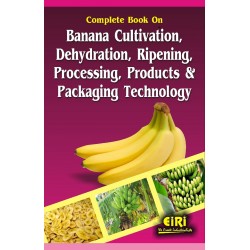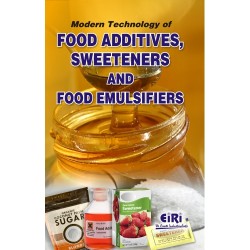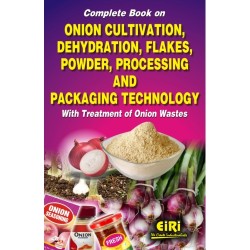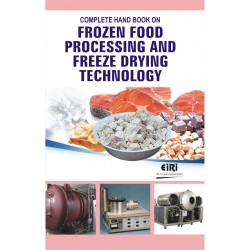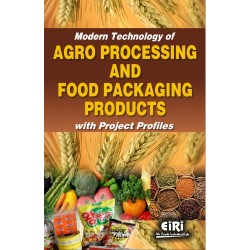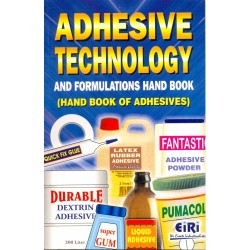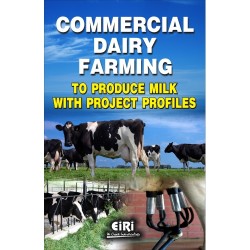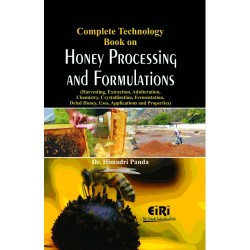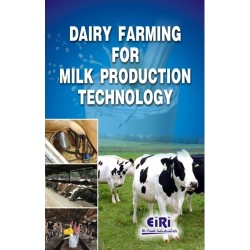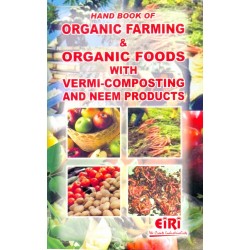Hand Book Of Flavours Technology (E-Book)
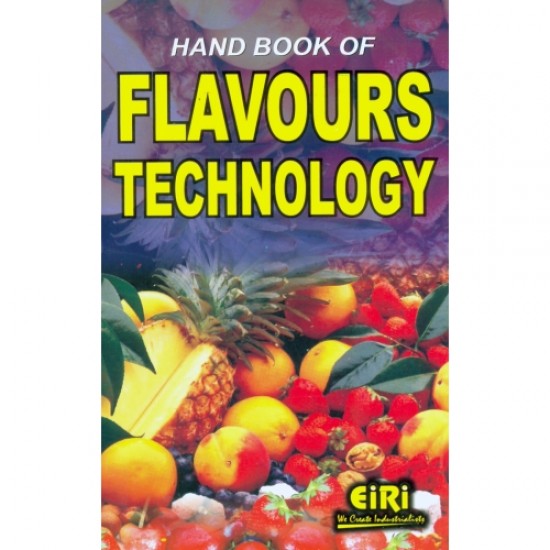
- More than 40 years of experience
- Managed by expert industrial consultants
- ISO 9001-2015 Certified
- Registered under MSME, UAM No: DL01E0012000
- 24/5 Research Support
Get your quesries resolved from an industry expert. Ask your queries before report or book purchase. - Custom Research Service
Speak to the our consultant to design an exclusive study to serve your research needs. - Quality Assurance
All reports are prepared by highly qualified consultants & verified by a panel of experts. - Information Security
Your personal & confidential information is safe & secure.
HAND BOOK OF FLAVOURS TECHNOLOGY
FLAVOUR ANALYSIS
- Sample Preparation
- Isolation of Food Flavours
- Headspace Methods
- Direct Injection
- Headspace Concentration
- Cryogenic Trapping
- Adsorbent Trapping
- Isolation of Flavours by Distillation Methods
- Isolation of Flavours by Solvent Extraction
- Equipment and Procedures
- Solvent Selection
- Solvent Impurities
- Solvent Extraction of Fatty Foods
- Isolation of Individual Classes of Volatile Flavours
- Sulfur Compounds
- Acids
- Alcohols
- Carbonyls
- Evaporation
- Freeze Concentration
- Adsorption
- Flavour Analysis by Direct Injection
- Gas Chromatography
- Fractionation of Flavour Isolates
- Gas Chromatography of Flavour Concentrates
- Capillary Column GC
- Chiral Gas Chromatography
- GC Detectors
- Quantification
- High Pressure Liquid Chromatography
- Identification of Volatile Flavours
- Summary
CHEMISTRY OF FLAVOURS
- Introduction
- Flavour Classification
- Flavour Formation in Plants
- Biogenesis of Fruits Aroma
- Flavours from Fatty Acid Metabolism
- Flavours Formed from Carbohydrate Metabolism
- Flavour Formation in Vegetables
- Flavour Formation from Cysteine Sulfoxide Derivatives
- Flavour formation from Gluconsinolates
- Additional Pathways for Vegetable Flavour Formation
- Location of Flavour in Plant
- Influence of Genetics, Nutrition Environment, Maturity and Storage on Flavour
- Conclusions
- Chemistry of Essential Oils
- Terpenes
- Oxygenated erpenoid Compounds
- Benzenoid Compounds
- Compounds Containing Nitrogen and Sulfur
- Nitrogen Compounds
- Sulfur compounds
- Sulfur Containing Oils
- White Mustard
- Black (Brown) Mustard
- Fruit Flavours
- Aromatic Components
- Fruit Sugars and Acids
- Sugars
- Monosaccharides
- Disaccharides
- Trisaccharides
- Nonsugars (Polysaccharides)
- Flavour of Dairy Products
- Milk
- Cheese
- Flavour Development
- Fatty Acids
- Carbonyls
- Sulfur Compounds
- Amino Acids and Peptides
- Flavour Balance
- Roquefort (Blue) Cheese Flavour
- Flavour Development
- Fermentation
- Fungi
- Black Tea Aroma
- Flavour Formation During Thermal Processing
- Nonenzymatic Browing
- General Overview of Maillard Browing
- Factors influencing Browning Rate
- Temperature
- pH
- Water Activity
- Influence of Fat
- Summary
- Formation of Flavour Comounds
- Flavours from Lipids
- Hydrolytic Reactions
- Oxidation
- Pyrolysis Reactions
- Effect of Frying Condition on Flavour
- Mechanisms of Flavour Formation
- Lactones
- Seafood Flaovurs
- Caramelization
- Flavours Formed Via Fermentation
- Esters
- Acids
- Carbonyis
- Alcohols
- Terpenes
- Lactones
- Pyrazines
- Conclusions
OFF FLAVOURS IN FOODS
- Environmental Contamination
- Waterborne Sources
- Off Flavours Due to In-Plant Water Contamination
- Tainting of Aquatic Animals by Contaminated Water
- Disinfectants, Pesticides and Detergents
- Packaging Sources
- Food Contamination
- Flavour Scalping
- Packaging Catalyzed Off Flavours
- Oxygen/Wate Vapour Transmission
- Off Flavours Due to Genetics or Diet
- Off Flavours Due to Chemical Changes in the Food
- Nonenzymatic Browning
- Photo Induced Off Flavours
- Milk
- Beer and Champagne
- Enzymatic Flavour Changes
- Lipoxygenase
- Lipase
- Proteolytic Enzymes
- Microbial Off Flavours
- Summary
MANUFACTURING PROCESSES OF FLAVOURS
- Introduction
- The Thermally Processed Flavours (Meat and Savory Flavours)
- Yeast and Autolyzed Yeast Extracts
- Basic Process Flavourings
- Complex Process Flavourings
- The Final Flavour
- Enzyme Modification and Fermentation The Dairy Flavours
- Milk and Cream Flavours
- Cultured Dairy Flavours
- Butter Flavour
- Cheese Flavours
- Creation of Dairy Flavours
- Regulatory Issues
- Appendix 4.1 IOFI Guidelines for the Production and Labeling of Process Flavours
- Introduction
- Scope
- Definition
- Basic Standards of Good Manufacturing Practice
- Production of Process Flavourings
- Raw Materials for Process Flavourings
- Preparation of Process Flavourings
- Appendix Table-A4.1
- Labeling
PLANT MATERIALS USED IN FLAVOURINGS
- 172.510 Natural Flavouring Substances and Natural Substances and Natural Substances Used in Conjunction with Flavours
- 182.10 Spices and Other Natural Seasonings and Flavourings
- 182.20 Essential Oils, Oleoresins (Solvent-Free), and Natural Extractives (Including Distillates)
- 182.40 Natural Extractives (Solvent Free) Used in Conjunction with Spices, Seasonings, and Flavourings
PRINCIPAL ESSENTIAL OILS USED IN FLAVOURINGS
APPLICATION OF FLAVOURINGS IN FOOD PROCESSING
- Flavours in Foods
- Achieving Flavour Balance
- Consumer Acceptance
- Flavour Defects
- Flavour Intensification
- Flavour Suppression
- Criteria for Application of Flavourings
- Acceptability to the Consumer
- Legal Acceptability
- Nature of Product as Sold and as Consumed
- Processing Conditions
- Available Flavourings
- Processing Parameters
- Temperature and Time
- Open or Closed System
- The Mixing Sequence
- pH
- Pressure
- Contact with Air
- specific Flavouring Applications
- Meat Products
- Baked Goods and Bakey Products
- Snack Foods
- Sugar and Chocolate Confectionery
- Pickles and Sauces
- soups
- Ice Cream and Frozen Goods
- Soft Drinks
- Conclusion
QUALITY CONTROL
- Analytical Tests
- Overview of Physicohemical Tests
- Natural Plant Materials
- General Tests
- Tests of Limited Application
- Additional Specific Tests
- Essential Oils
- General Tests
- Tests of Limited Application
- Instrumental Tests
- Specific Test for Constituents
- Tests Specific for Citrus Oils
- Specific Tests and Producedures
- Oleoresins
- General Tests
- Specific Tests
- Plated or Dispersed Spices
- General Tests
- Tests of Limited Application
- synthetic Chemicals
- General Tests Liquids
- General Tests Solids
- Specific Tests for Chemical Identity and Purity Instrumental Methods
- Flavourings
- General Tests Liquid Flavourings
- General Tests Emulsions
- General Tests Encapsulated Dry Flavourings
- Vanilla Extract
- Fruit Based Products
- General Tests
- Special Tests
- Specific Gravity
- Refractive Index
- Optical Rotation
- Alcohol Content
- Residual Solvent
- Practicle Size of Emulsions
- Volatile Oil
- Surface Oil
- Moisture Content
- Gas Chromatography
- Microbiological Analysis
- Sensory Analysis
NON-ALCOHOLIC FLAVOURS
- Compounding
- Plant Economics of Non-Alcoholic Flavours
- Plant & Machinery
- Other Fixed Assets
- Fixed Capital
- Raw Materials
- Total Working Capital/Month
- Total Capital Investment
- Turn Over/Annum
FLAVOURS FRUIT (WHISKEY, VODKA, GRAPE, BUTTER SCOTCH AND RUM)
- Artificial Flavourings
- Manufacturing Process
- For Rum Flavour
- Process Flow Diagram for Rum Flavour
- Plant Economics of Fruit Flavours
- Plant and Machinery
- Other Fixed Assets
- Fixed Capital
- Raw Materials
- For Rum Flavour
- For Whiskey Flavour
- For Grape Flavour
- For Butter Scotch Flavour
- Total Woring Capital/Month
- Total Capital Investment
- Turn Over/Annum
TERPENELESS MENTHOL CRYSTALS
- Manufacturing Process Fractional Distillation of D.M.O. for Removal of Terpene
- Extraction of Menthol
- Crystallization
- Separation of the Menthol Crystals from the Dementholized Oil
- Drying of Menthol Crystals
- Yield of Menthol & Dementholized Mint Oil
- Plant Economics of Terpeneless Menthol Crystals
- Plant & Machinery
- Other Fixed Assets
- Fixed Capital
- Raw Materials
- Total Working Capital/Month
- Total Capital Investment
- Turn Over/Annum
Engineers India Research Institute (EIRI) is a renowned name in the industrial world for offering technical and financial consultancy services.
EIRI services are:
- Detailed Feasibility Reports
- New Project Identification
- Project Feasibility and Market Study
- Identification of Lucrative Industrial Project Opportunities
- Preparation of Project Profiles / Pre-Investment and Detailed Feasibility Studies,
- Market Surveys / Studies, Market Survey Cum Detailed Techno-Economic Feasibility Reports
- Project Reports in CD Roms
- Identification of Plant /Process/Machinery and Equipment, Industrial General Guidance for setting up new industrial projects.
Our most up-to-date and Technologically Advanced Industrial Project Reports, categorized with respect to Financial Outlays and Sector – wise Classification are immensely useful for :
- Existing Small or Medium Scale Industrialists facing competition from large houses
- Young Entrepreneurs dreaming to start their own industrial enterprise
- Young Graduates and Professionals wishing to begin their career
- Industrialists interested in Debottlenecking their capacities & New Product – Lines
- Large Industrial Houses pursuing Expansion, Growth and Diversification Plans
How to Make Project Report?
Detailed Project Report (DPR) includes Present Market Position and Expected Future Demand, Technology, Manufacturing Process, Investment Opportunity, Plant Economics and Project Financials. comprehensive analysis from industry covering detailed reporting and evaluates the position of the industry by providing insights to the SWOT analysis of the industry.
Each report include Plant Capacity, requirement of Land & Building, Plant & Machinery, Flow Sheet Diagram, Raw Materials detail with suppliers list, Total Capital Investment along with detailed calculation on Rate of Return, Break-Even Analysis and Profitability Analysis. The report also provides a birds eye view of the global industry with details on projected market size and then progresses to evaluate the industry in detail.
We can prepare detailed project report on any industry as per your requirement.
We can also modify the project capacity and project cost as per your requirement. If you are planning to start a business, contact us today.
Detailed Project Report (DPR) gives you access to decisive data such as:
- Market growth drivers
- Factors limiting market growth
- Current market trends
- Market structure
- Key highlights
Overview of key market forces propelling and restraining market growth:
- Up-to-date analyses of market trends and technological improvements
- Pin-point analyses of market competition dynamics to offer you a competitive edge major competitors
- An array of graphics, BEP analysis of major industry segments
- Detailed analyses of industry trends
- A well-defined technological growth with an impact-analysis
- A clear understanding of the competitive landscape and key product segments
Need Customized Project Report?
- Ask for FREE project related details with our consultant/industry expert.
- Share your specific research requirements for customized project report.
- Request for due diligence and consumer centric studies.
- Still haven't found what you're looking for? Speak to our Custom Research Team
About Engineers India Research Institute:
Note: We can also prepare project report on any subject based on your requirement and country. If you need, we can modify the project capacity and project cost based on your requirement.
Our Clients

Our Approach
- Our research reports comprehensively cover Indian markets (can be modified as per your country), present investigation, standpoint and gauge for a time of five years*.
- The market conjectures are produced on the premise of optional research and are cross-accepted through associations with the business players
- We use dependable wellsprings of data and databases. What's more, data from such sources is handled by us and incorporated into the report
Why buy EIRI reports?
- Our project reports include detailed analysis that help to get industry Present Market Position and Expected Future Demand.
- Offer real analysis driving variables for the business and most recent business sector patterns in the business
- This report comprehends the present status of the business by clarifying a complete SWOT examination and investigation of the interest supply circumstance
- Report gives investigation and top to bottom money related correlation of real players/competitors
- The report gives gauges of key parameters which foresees the business execution





















